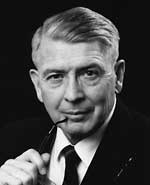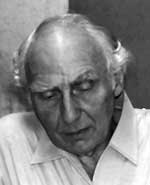Dr. Harold Francis Falls
Dr. Harold Francis Falls, Brighton, an ophthalmologist who played an early and influential role in the field of medical genetics, died of congestive heart failure May 27 at age 96. Dr. Falls helped establish one of the first human genetics clinics in the nation and devoted his long career to building a rich collection of genetic histories of eye disease that still are being studied today.

Emeritus professor of the Department of Ophthalmology and Visual Sciences, Dr. Falls started to make his mark in genetics very early, while he was a resident at the U-M Medical School. In 1941 he helped establish the Heredity Clinic, widely recognized as the first of its kind in the nation. Two years later he was named medical director of the clinic.
Dr. Falls was prescient in understanding the importance of hereditary disease patterns. In his study of Cooley’s anemia, for example, he began to lay out the principles underlying
X-linked inheritance patterns, in which the female carries the mutation and passes it on to a son. He furthered his exploration of X-linked inheritance in eye disease in 1948 when he published a study of a large family with retinitis pigmentosa. Dr. Falls later described the phenotype of X-linked retinoschisis as well. He also made major contributions to the descriptions of retinoblastoma, ocular albinism, blue cone monochromacy and the Indiana form of amyloidosis. In 1951, he published a paper on a type of ocular albinism that became known as the Nettleship-Falls Syndrome.
“Dr. Falls was the early central figure in developing the genetic basis of eye diseases,” says Dr. Paul Sieving, director of the National Eye Institute, at the National Institute of Health (NIH), and a former faculty member of the U-M Department of Ophthalmology and Visual Sciences. “His clinical descriptions of hereditary retinal diseases, in what was then a relatively new field of study, formed the basis for my own work in ophthalmic genetics, and that of many others. The modern stage is now being set to develop treatments for these genetic diseases first introduced to medicine by Harold Falls,” he said.
A keen observer and highly respected teacher, Dr. Falls encouraged his residents to study the relatives who accompanied patients, noting that they might reveal the carrier states of the disease about which the patient complained. Reflecting on his work, he recalled telling residents, “No medical history was complete without the question, ‘Does anyone in your family have a similar disease?'”
“Many experts consider Dr. Falls to be the founder of medical genetics,” observes Dr. Paul R. Lichter, chair of the department of Ophthalmology and Visual Sciences. “Harold Falls had profound insights into medical genetics in the early 1940s, well ahead of his peers in any medical field,” he said. “His colleagues in ophthalmology regard him as the undisputed master of clinical genetics in ophthalmology.”
Dr. Falls was born in Winchester, Ind. Nov. 25, 1909, and later moved to Detroit. He completed his medical education at U-M in 1936 and his residency in ophthalmology in 1942. In addition to directing the Heredity Clinic, he became a member of the U-M Hospital staff. He was named professor of ophthalmology in 1959 and retired in 1975. Dr. Falls held numerous leadership positions in local, state and national medical associations.
In 2003 colleagues and alumni honored him by establishing the Harold F. Falls Collegiate Professorship in Ophthalmology and Visual Sciences. Anand Swaroop, whose work focuses on the genetics of retinal diseases and age-related macular degeneration, holds the professorship. The family has requested that memorial donations be made to the professorship through the Kellogg Eye Center, 1000 Wall Street, Ann Arbor, MI 48105.
In addition to wife Emeline, Dr. Falls is survived by his children Thomas (Judith) Falls, Hariette Falls (James) Gray, and Timothy (Patty) Falls; grandchildren Kelly Falls, Dr. Thomas James Falls, Jennifer (Brian) Moss, Carolyn Gray, Eric Falls, Jonathon Falls and Andrea Falls (Tony) Isaacs.
A memorial service was held June 3 at the Borek Jennings Funeral Home in Hamburg.
William A. Lunk
William A. Lunk, former preparator, curator, associate director and acting director of the U-M Exhibit Museum of Natural History, died May 18 at age 87. He earned a master’s degree in zoology and a doctorate in ornithology from the University, and worked his entire career at the museum, 1949-1989. After retirement, he volunteered at the Exhibit Museum and at the Museum of Paleontology.

Although Lunk had no formal art or design training, his natural talent and artistic skills were instrumental in the museum’s transition from the specimens-on-shelves displays earlier in the 20th century to the more educational didactic displays (text and specimens) still common today. Much of Lunk’s work remains on exhibit in the museum’s Hall of Evolution.
“I’ve liked every step in the procedure of putting together an exhibit,” he has said, “from the initial research and layout, to everything involved in the final installation: model-making, construction, painting, and preparing labels and text.”
Born May 6, 1919 in Johnstown, Penn., Lunk married Mary Hunsaker in 1947. He was a captain in the U.S. Army during World War II in the Pacific Theater.
He was a published illustrator who enjoyed reading, bird watching, walking in the woods, working in the yard and his dogs. Lunk is survived by his wife, four children—Edward, Susan, Allan, and Peggy—and their spouses, five grandchildren and his canine buddy Bartow, a Bouvier.
In lieu of flowers the family has requested that memorial gifts be made to the Exhibit Museum of Natural History, 1109 Geddes Ave., Ann Arbor, MI 49109-1079 for the “Bill Lunk Fund.”
—Submitted by U-M Exhibit Museum of Natural History

